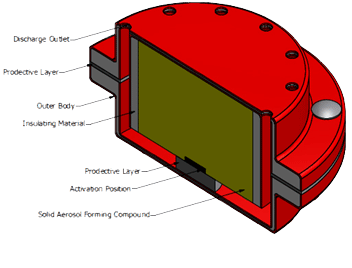INTRODUCTION
 Dry Sprinkler Powder Aerosol , Popularly known as DSPA . Produced in Europe. Aerosol as an extinguishing agent got recognition as an agent for fire suppression in end 2009, through standard NFPA2010. Application of aerosol as fire suppression agent is most latest innovation in the direction of development.
Dry Sprinkler Powder Aerosol , Popularly known as DSPA . Produced in Europe. Aerosol as an extinguishing agent got recognition as an agent for fire suppression in end 2009, through standard NFPA2010. Application of aerosol as fire suppression agent is most latest innovation in the direction of development.
Aerosol The Fire Suppression Agent
- Extinguishes A, B, C, E and F class of fire.
- Suitable for fire in closed space as full flooding system.
- Most effective in extinguishing full fire in few seconds as mass required is smallest (30 – 100 gm/ M3) compared to mass of any other fire extinguishing agent and so relelese of least mass from enclose is very short.
- Small in shape and require no extra space. Kept in the room requiring fire protection.
- Although it is not an clean agent but leaves nil or negligible residues in the room as most of the particles go away like a cloud, on opening the room. The remainant can be cleared by vacuum cleaner.
- Zero ozone depletion.
- Zero global warming potential
- Lowest atmospheric life among all agents. So safest for environment.
- No toxicity, not replacing oxygen in room & safe for life present in the room during release.
- Non corrosive to electronic material and non conductive even at 40 kv dielectric strength. Safe for electronic circuit.
- Life of particle in side container is 15 years.
Product Certificate
- DSPA complies NFPA 2010 guide lines for aerosol generator application.
- Reviewed for ozone depletion potential, global warming potential, toxicity, flammability, and exposure potential as per official SNAP listing by the U.S. Environmental Protection Agency.
- Investigation in accordance with UL 2775.
- BRE Fire & Security / BRE Global, observed fire test with aerosol extinguishing system UL2127, No. 121351. BRE Fire & Security / BRE Global, test with DSPA aerosol suppression system for prison cell fire protection, No. 246190.
- Intertek ETL SEMKO, Product evaluation & test report UL 711 (Modified). No. 314579.
- RINA, condensed aerosol extinguishing system – witness report. No. 2007CS015767.
- Approvals, recognition by government and leading agencies in fire from many nations are available on request.
Principle of Working
- Condensed aerosol with potassium compound of 2- 5 micron.
- The potassium radicals combines with free radicals produced by fire and cut the fire chain to suppress fire.
Feature (During Storing / Inactive)
- Non pressurized .
- Does not ignite bellow 300 deg C.
Feature on Release of Active Mass
- When ignited releases particles like a cloud containing 60 % aerosol and 40 % active agent and remain suspended in air.
- Does not explode or burst when activated. The heat released is distributed closely around the container.
- DSPA devices emits no pressure even at closest point on ignited.

